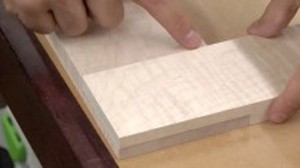Incorporate your highest standards and best practices into even the roughest of projects. It’s good practice, it keeps your skills up and prevents falling into bad habits. If it takes a little longer, it is time well-spent. For example, I recently built a handrail on my outdoor deck project.

For the first 18 years of our home’s life we had no railing whatsoever on our deck. We like the open view as seen here. Recognizing the increasing danger of falling as we age, we decided we should at least have something to grab onto if we stumbled, yet still maintain the beautiful view.
It certainly didn’t need to be fancy. It needed to be splinter-free and strong in case anyone fell against it (it’s about 10 feet down at the high end and close to 20 at the low end.). As I was working on this, I tried to get my half-laps as tight and flat as possible. Sure, it makes for a better-looking end product, but it provides the practice to making good-looking joints, too.
Half-lap joints may usually be thought of as being the stuff of fence rails and hidden structural parts. It just happened that Marc Spagnuolo published a mirror frame project video while I was working on these handrail half-laps, raising the half-lap to an art form.

This is a beautiful example of a half-lap joint at its finest, by Marc Spagnuolo (permission granted for reprint)
A half-lap joint is a blowout waiting to happen, with the very high risk of missing chunks of wood existing on all four sides. One must be careful to either provide a backer-board for each cut, or work toward the inside of the joint. If the “lap” is too high or too low, the joint is ugly and sloppy-looking. Ditto if the shoulders aren’t square. But, it’s all about how much time and care one is willing to invest in a project to have it look as good as it can be.
When visitors lean against my handrail I want them to be able to marvel at the quality of the workmanship. Even if no one ever came to see us, when I look at the rails I want to be able to be proud of them. The point is not whether I always achieved fine woodworking with my handrail project. The point is that I strove for it and sought to do my best at every step along the way, keeping my standards high.
Jim Randolph is a veterinarian in Long Beach, Mississippi. His earlier careers as lawn mower, dairy farmer, automobile mechanic, microwave communications electronics instructor and journeyman carpenter all influence his approach to woodworking. His favorite projects are furniture built for his wife, Brenda, and for their children and grandchildren. His and Brenda’s home, nicknamed Sticks-In-The-Mud, is built on pilings (sticks) near the wetlands (mud) on a bayou off Jourdan River. His shop is in the lower level of their home. Questions and comments on woodworking may be written below in the comments section. Questions about pet care should be directed to his blog on pet care, www.MyPetsDoctor.com. We regret that, because of high volume, not all inquiries can be answered personally.

